University of Applied Arts Vienna presents twelve architecture student projects
Dezeen School Shows: a project exploring cohabitation between beavers and humans through the use of soil and synthetic elastic is included in this school show by the University of Applied Arts Vienna.
Also included is a redesign of a venue to integrate the community and a project exploring cotton farming.
University of Applied Arts Vienna
Institution: University of Applied Arts Vienna
School: Institute of Architecture
Course: Master of Architecture
Tutors: Prof Cristina Díaz Moreno, Prof Efrén García Grinda, Prof Greg Lynn, Prof Sam Jacob, Hannes Traupmann, Christopher Gruber, Anna Gulinska, Zsuzsa Péter, Christina Ehrmann, Maja Ozvaldic, Lenia Mascha, Bence Pap, Kaiho Yu, Sophie C Grell, Eldine Heep, Sophie Luger and Giacomo Pala
School statement:
"The Institute of Architecture (IoA) at the University of Applied Arts Vienna/die Angewandte offers a three-year accredited master's program focused on experimental and innovative design in architecture and urban practices.
"The institute is embedded in an internationally renowned applied arts university that fosters interdisciplinary collaboration, provides state-of-the-art education in artistic fields and research and promotes global exchange.
"With its international orientation and profound artistic, technical and discursive educational program, the Institute of Architecture produces critical work and searches for visionary architecture that addresses the most urgent questions of our time and the near future.
"To create new schemes and visions in education, research and practice that address these challenges, architecture at the Institute of Architecture is taught as an integrative discipline by promoting interdisciplinary project processes and working methods from the very local to the planetary.
"Just as there are many areas and niches within architecture and the professional field of architects, the university proclaims diversity on all levels, including teaching.
"Consequently, the autonomy of all the institute's design studios and departments is crucial and considered to be productive, provoking more critical discourse, projects and dynamics."
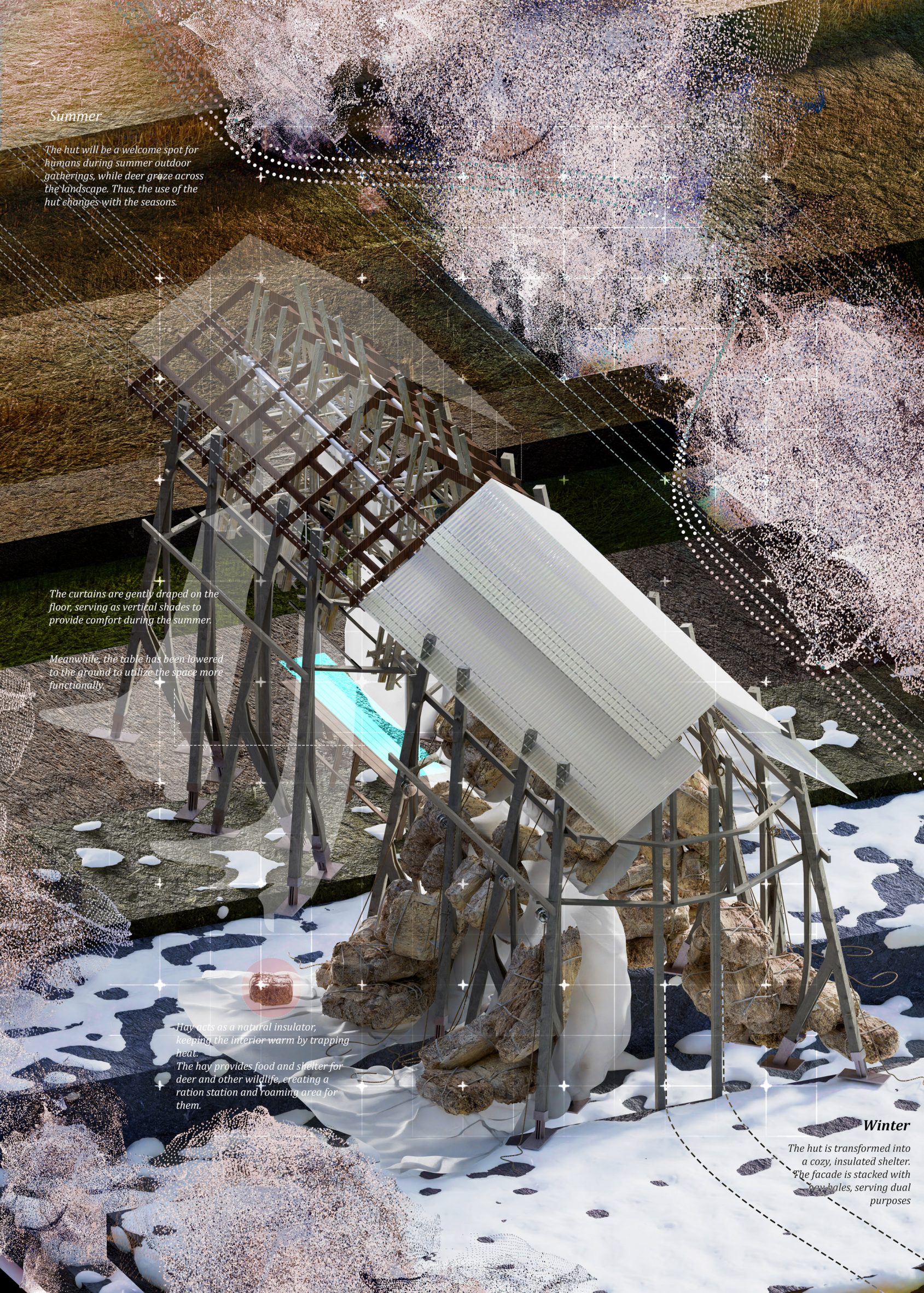
Mutual Presence by Thomas Luckmann, Pang Jun Wei and Burhan Gün Rodoplu
"Seeking an inter-species relationship, the concept of hunting was examined – the largest, most intelligent and socially capable animal to be found was deer.
"Just outside of Vienna to the south, on agricultural croplands at Vösendorf, the site exhibits very few physical reference points – deer are usually found in the middle of croplands as well as on the fringes.
"To understand and address the challenges of the large site, the analogy of the 'house' was used: the living room as the middle point of the croplands, whilst also considering the human element of landscape and enjoying the garden.
"Replicated in our model, we are proposing to collect hay in nets and fabrics, where the haystack is both the material of the building and the feedstock for the deer."
Students: Thomas Luckmann, Pang Jun Wei and Burhan Gün Rodoplu
Studio: Studio Diazmoreno Garciagrinda
Tutors: Cristina Díaz Moreno, Efren García Grinda, Christina Ehrmann, Christopher Gruber, Anna Gulinska, Zsuzsa Péter and Hannes Traupmann
Emails: thomas-friedrich.luckmann[at]student.uni-ak.ac.at, jun-wei.pang[at]student.uni-ak.ac.at and burhan-guen.rodoplu[at]student.uni-ak.ac.at
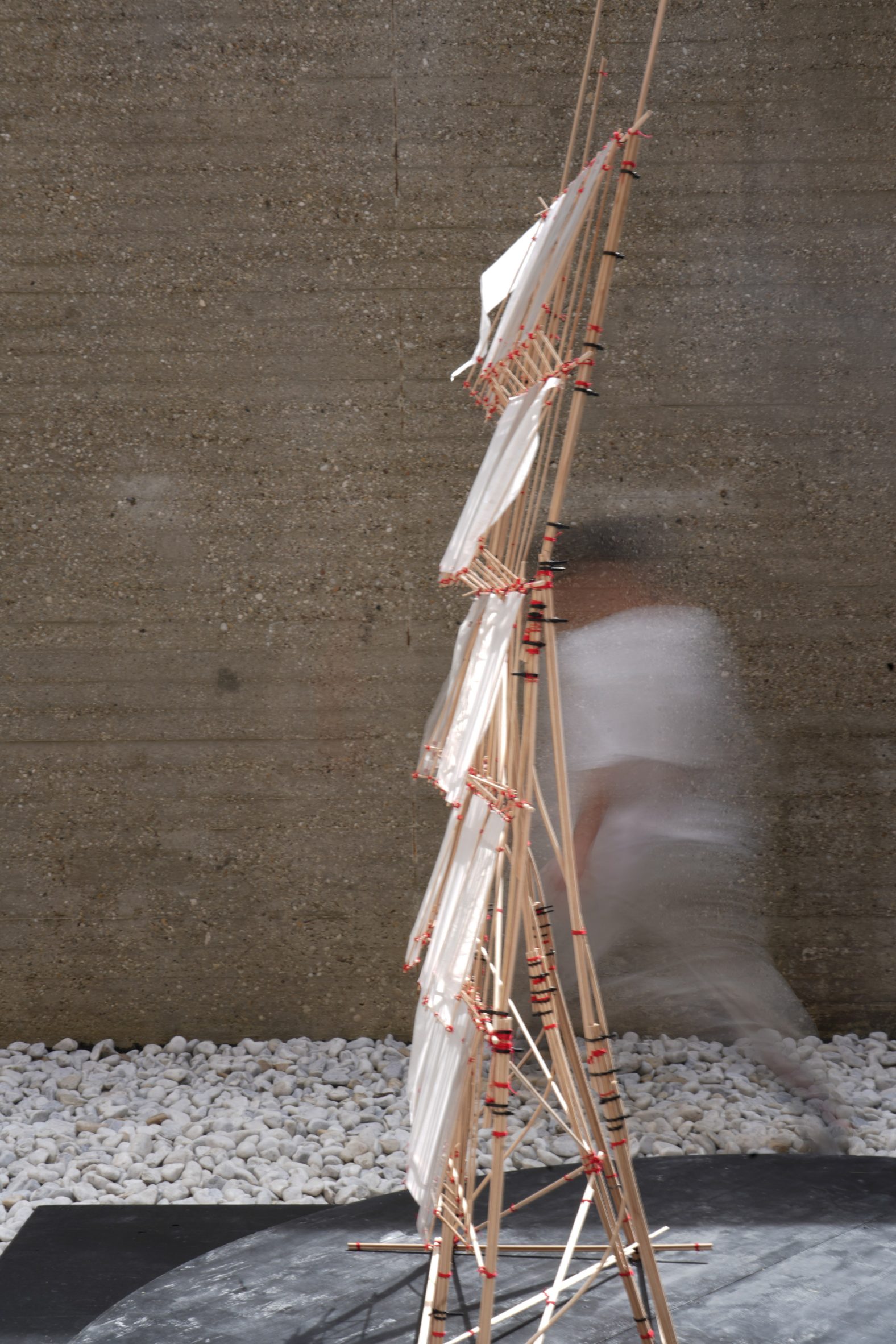
Riah Palace by Hao Lu, Ramita Keeratiurai and Réka Nisnánszky
"Focusing on cotton for its shapes, texture and deep relationship with human society, we found interesting insights about its fibres and cultivation – cotton requires a lot of water and pesticides to grow as it has been genetically modified for human preferences, such as whiteness and fluffiness.
"We investigated organic farming methods to grow cotton in a better environment, locating a farm where wild cotton varieties with numerous environmental benefits are grown using natural methods, and selected 20 of these to use in our own garden design.
"Egypt is well-known for its cotton and has the perfect climate for its cultivation, with suitable land for cultivation on either side of the Nile River – however, urbanisation is encroaching on agricultural land, pushing farmland and residents into the desert to find available land.
"We explored the relationship between cotton and city development, focusing on Cairo's boundary and the idea of using wind to spread cotton seeds, preserving agricultural land and interrupting urbanisation.
"The garden can be accessed from the city, utilising existing water irrigation as the main resource, the walls are oriented to allow wind flow to carry and disperse seeds through the garden and plants are strategically placed to control pests, create privacy and regulate the landscape."
Students: Hao Lu, Ramita Keeratiurai and Réka Nisnánszky
Studio: Studio Diazmoreno Garciagrinda
Tutors: Cristina Díaz Moreno, Efren García Grinda, Christina Ehrmann, Christopher Gruber, Anna Gulinska, Zsuzsa Péter and Hannes Traupmann
Emails: hao.lu[at]student.uni-ak.ac.at, ramita.keeratiurai[at]student.uni-ak.ac.at and reka.nisnnszky[at]student.uni-ak.ac.at
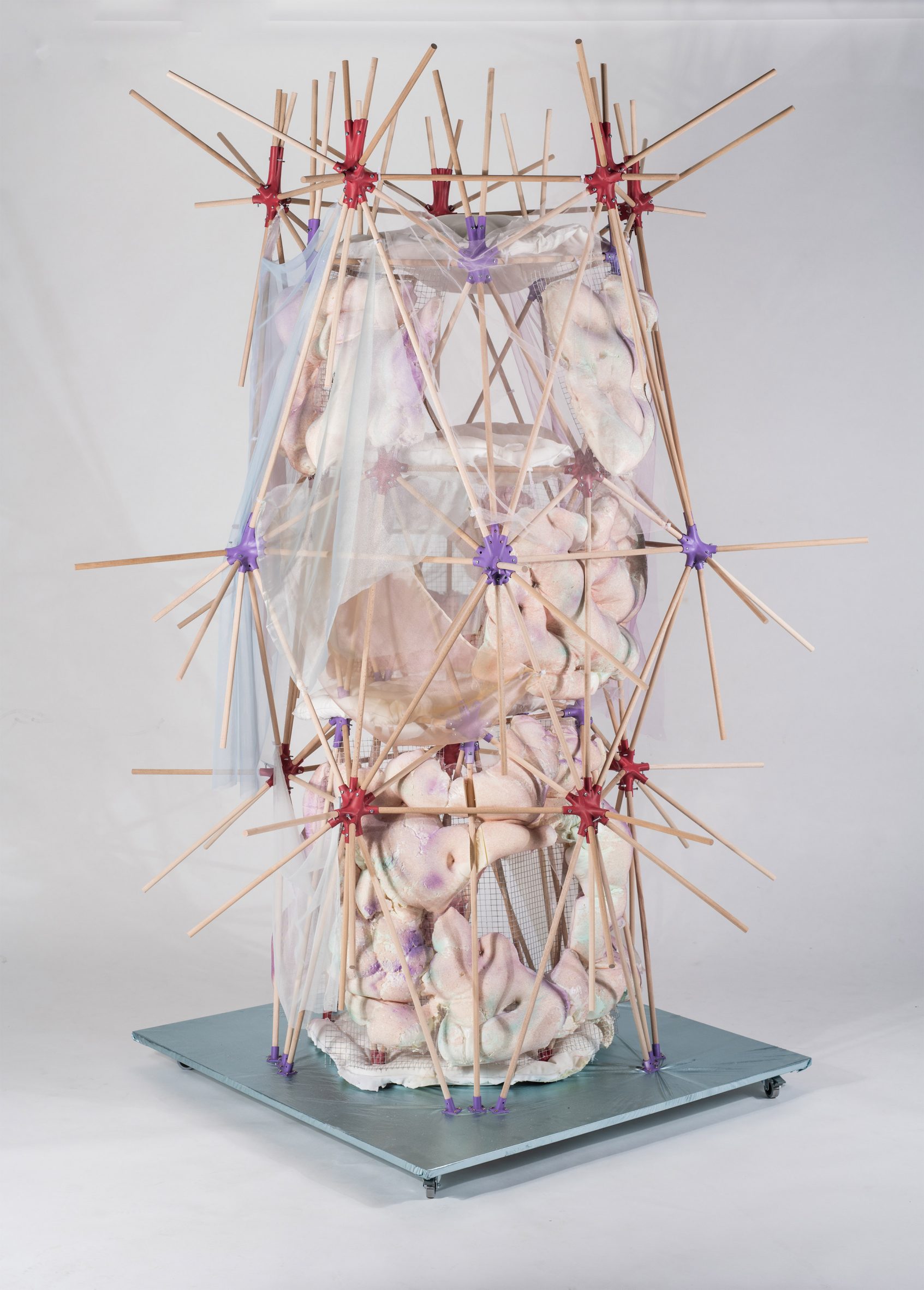
Up Above and In Between (Scaffolds of Sympoiesis) by Apoorva Thapa, Jiayi He, Soultana Zachariadou and Yunxi Wu
"Etched into the European zeitgeist as symbols of rebirth, regeneration, rewilding and hope, white storks have endured a milieu of evolving cultures, terrains, climates and shifting borders, forcing them to establish a residence in landfills.
"Madrid's Southeast Regional Park (PRS) is home to some of the largest landfills in Europe, but also contains a diverse array of ecosystems, from wetlands to gypsiferous plains and cliffs.
"We wanted to explore how industrial vertical typologies, such as radio towers and pylons – often the nesting grounds for migratory birds – could be reimagined as spatialities that encourage mutual comfort through notions of intimacy and spatial memory.
"The proposal creates a series of typological towers between the cliff and river alongside the existing hiking track, providing the temporary and/or permanent settlement for the humans and storks in the park.
"Locally resourced material such as gypsum, recycled plastic panels and fabric will be applied in the slender steel structure."
Students: Apoorva Thapa, Jiayi He, Soultana Zachariadou and Yunxi Wu
Studio: Studio Diazmoreno Garciagrinda
Tutors: Cristina Díaz Moreno, Efren García Grinda, Christina Ehrmann, Christopher Gruber, Anna Gulinska, Zsuzsa Péter and Hannes Traupmann
Emails: athapa[at]student.uni-ak.ac.at, jiayi.he[at]student.uni-ak.ac.at, soultana.zachariadou[at]student.uni-ak.ac.at and yunxi.wu[at]student.uni-ak.ac.at
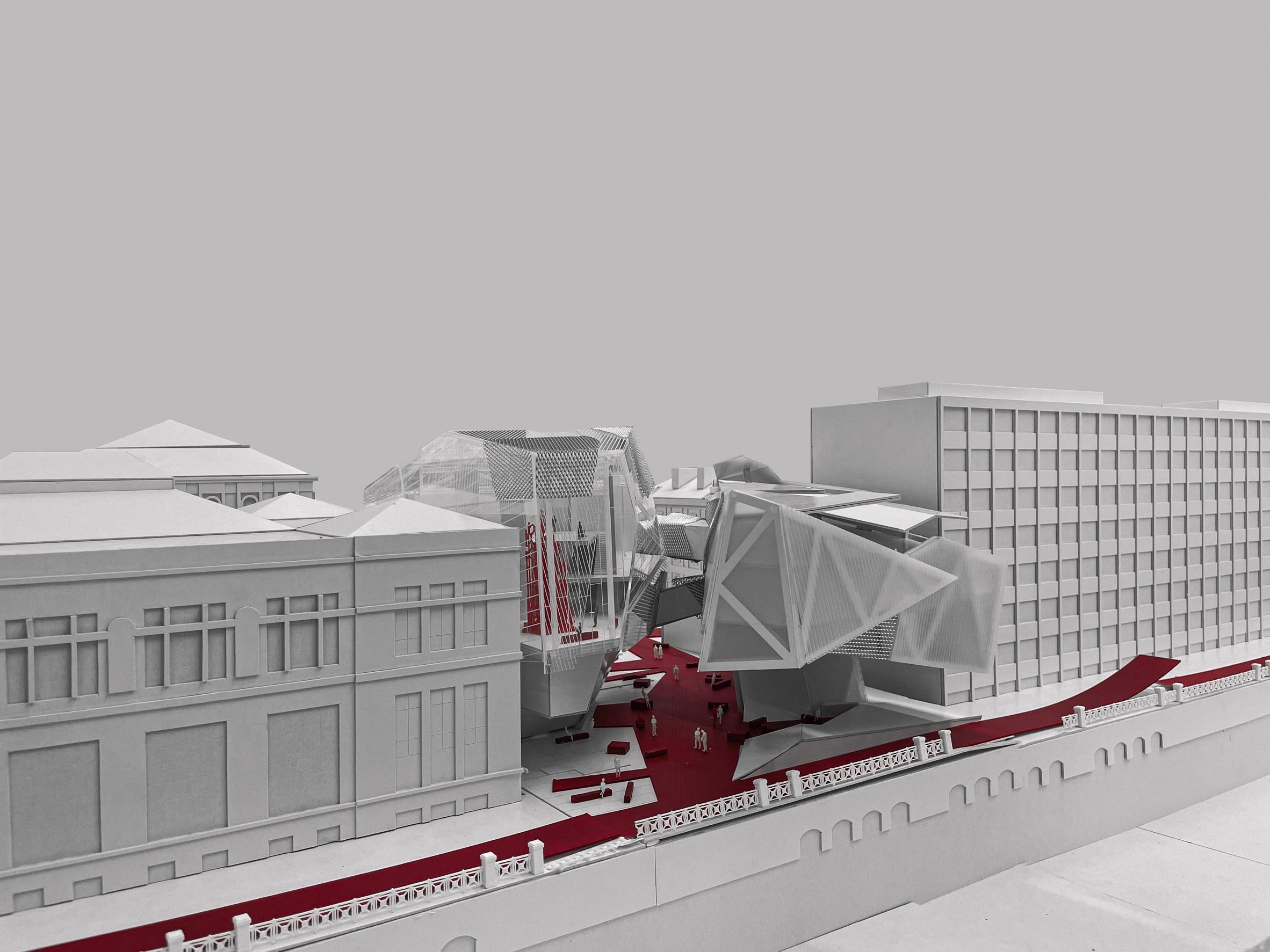
Cut and Connect by Markus Lagler, Abhishek Blesson Manuel and Kimia Lotfi
"By separating the massing into multiple entities, we aim to balance individuality with collective coherence – this design approach creates a network of spatial relationships, redefining forms through both separation and integration and allowing us to explore how these volumes interact and relate to one another.
"When applied to the ground level, this method extends the exploration to the urban scale, examining how these volumes engage with and enhance the surrounding urban environment.
"By focusing on the quality of in-between spaces, the design treats the canyon as a unifying element, connecting the separated buildings within the urban fabric.
"This approach not only highlights the unique characteristics of each volume but also fosters a cohesive urban landscape – the interplay between the individual structures and the collective whole enriches the spatial experience, creating dynamic and engaging environments that contribute to the vitality of the urban setting."
Students: Markus Lagler, Abhishek Blesson Manuel and Kimia Lotfi
Studio: Studio Greg Lynn
Tutors: Greg Lynn, Lenia Mascha, Maja Ozvaldic, Bence Pap and Kaiho Yu
Emails: markus.lagler[at]gmx.at, abhishekblessonmanuel[at]gmail.com and kimialotfi2312[at]gmail.com
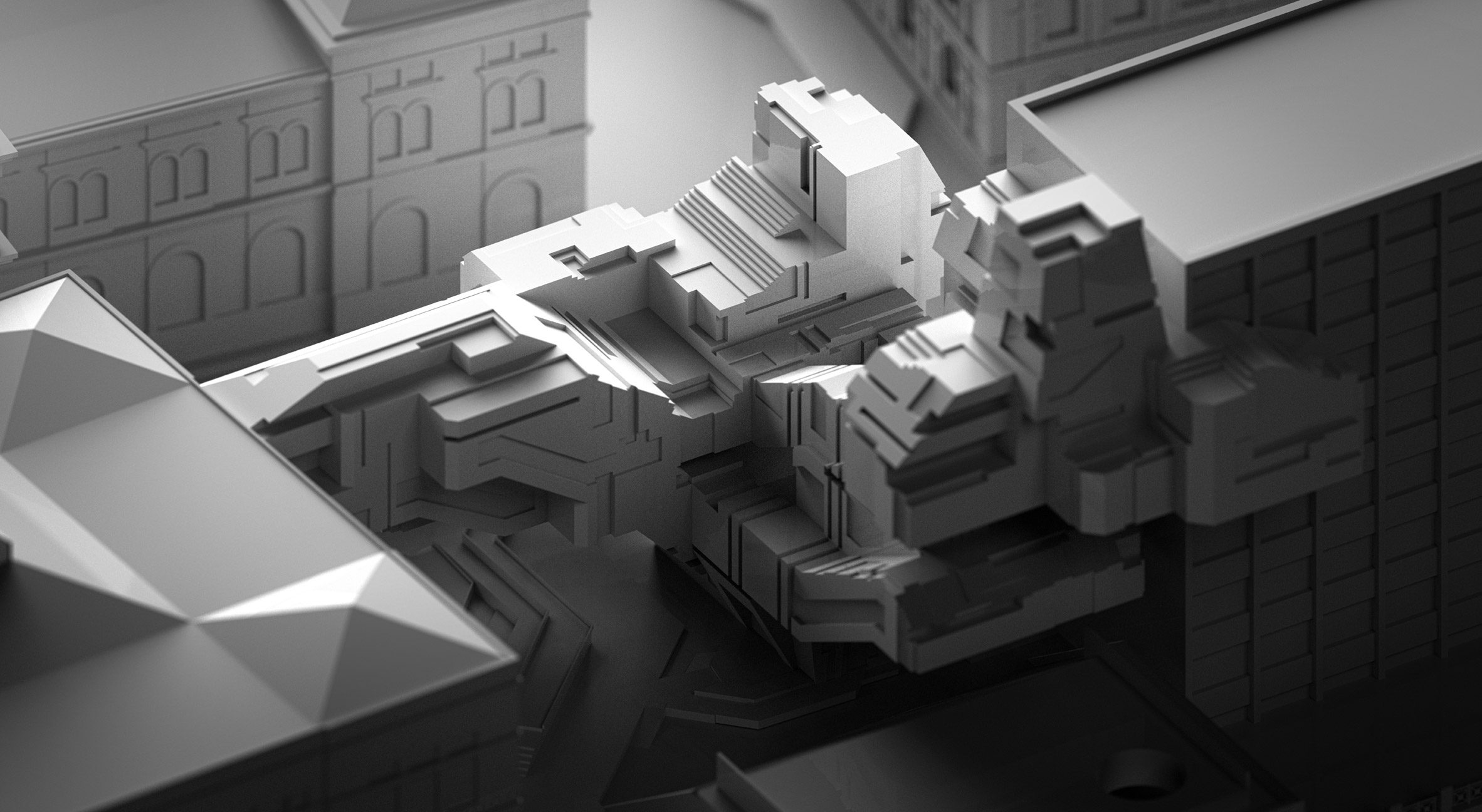
Angewandte Annex by Akash Deep Ravichandran, Merve Ozcan and Kimberly Leon
"The Angewandte Annex, an extension of the University of Applied Arts, is located in the heart of Vienna between the university and the MAK (Museum of Applied Arts) – it comprises studios, media rooms, lecture halls, lounge areas, ateliers and exhibition spaces, linking Fritz-Wotruba and Ringstrasse while creating courtyards for both institutions.
"Academic functions are positioned closer to the university, while social spaces are nearer to MAK.
"The circulation areas also serve as exhibition spaces, weaving through various functional zones to create a fluid, interconnected environment, with physical connections to both the university and MAK to enhance accessibility.
"The Annex features a minimal ground footprint that expands vertically, maximising courtyard use and creating inviting spaces below."
Students: Akash Deep Ravichandran, Merve Ozcan and Kimberly Leon
Studio: Studio Greg Lynn
Tutors: Greg Lynn, Lenia Mascha, Maja Ozvaldic, Bence Pap and Kaiho Yu
Emails: akashdeep.ravichandran[at]gmail.com, merveozcanarch97[at]gmail.com and kimberly01leon[at]gmail.com
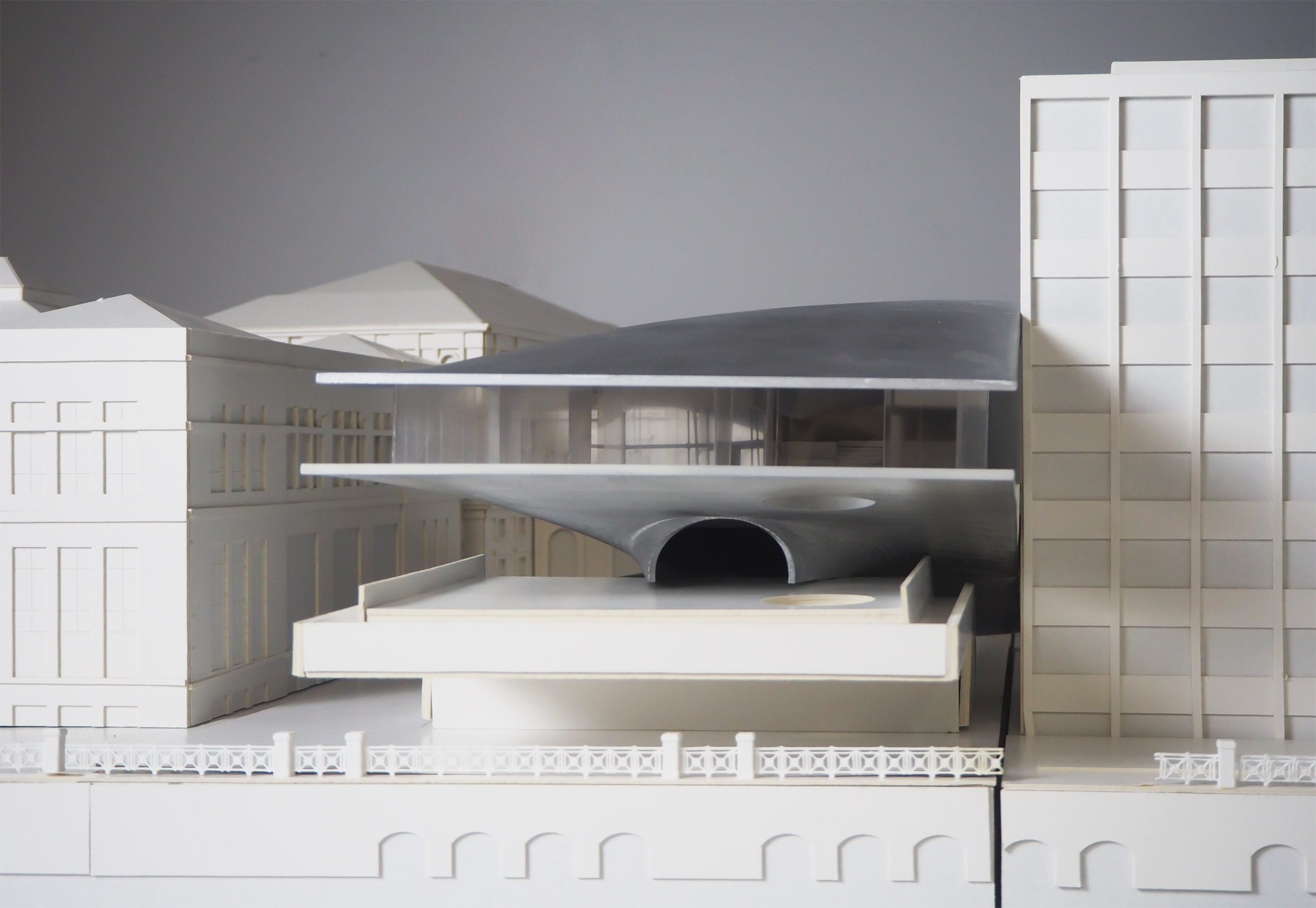
Surface-Scape by Weichen Zhou, Emiliano Perez and Martin Sepp
"Located within a complicated historical context, this project tries to create a connection between the Museum of Applied Arts (MAK) and the University of Applied Arts (Angewandte) by facilitating a civic engagement with art and design.
"The surface spans acrpss the garden and the art terrasse plateau, designed by artist Peter Noever, enriching the urban landscape by facilitating public events under the floating canopy.
"Within the surface is a contrasting block-like yet free-flowing landscape of floors, which promotes the fluid movement of the public and the institutions, mixing functions of exhibition and education."
Students: Weichen Zhou, Emiliano Perez and Martin Sepp
Studio: Studio Greg Lynn
Tutors: Greg Lynn, Lenia Mascha, Maja Ozvaldic, Bence Pap and Kaiho Yu
Emails: jowcharly[at]gmail.com, emilianop2002[at]gmail.com and martinsepp104[at]gmail.com
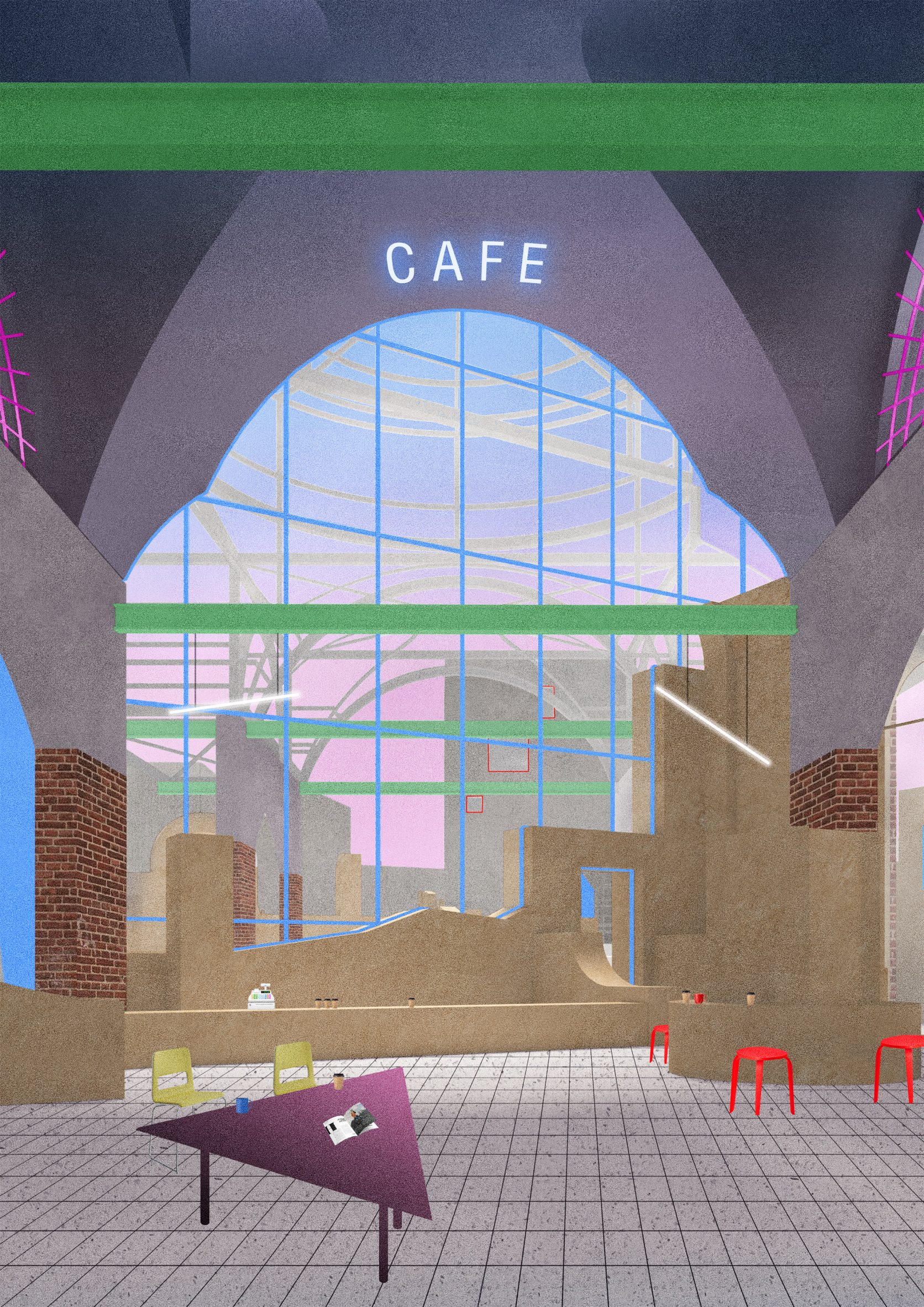
Fables of the Reconstruction: A Testing Ground by Christiane Braml, Joel Nikels and Mintong Lu
"Our project, Fables of Reconstruction, takes a literal and exploratory approach to the concept of reconstruction, using the ruins of Soane's Bank of England as a testing ground.
"In contemporary discourse, reconstruction often suffers from a negative reputation – copying and replicating historical structures are seen as unfashionable or inauthentic.
"However, the history of reconstruction is rich and complex, with significant debates and differing."
Students: Christiane Braml, Joel Nikels and Mintong Lu
Studio: Studio Sam Jacob
Tutors: Sam Jacob, Sophie Grell-Prix, Eldine Heep, Sophie Luger and Giacomo Pala
Emails: christiane-elisabeth.braml[at]student.uni-ak.ac.at, joel.nikles[at]student.uni-ak.ac.at and mintong.lu[at]student.uni-ak.ac.at
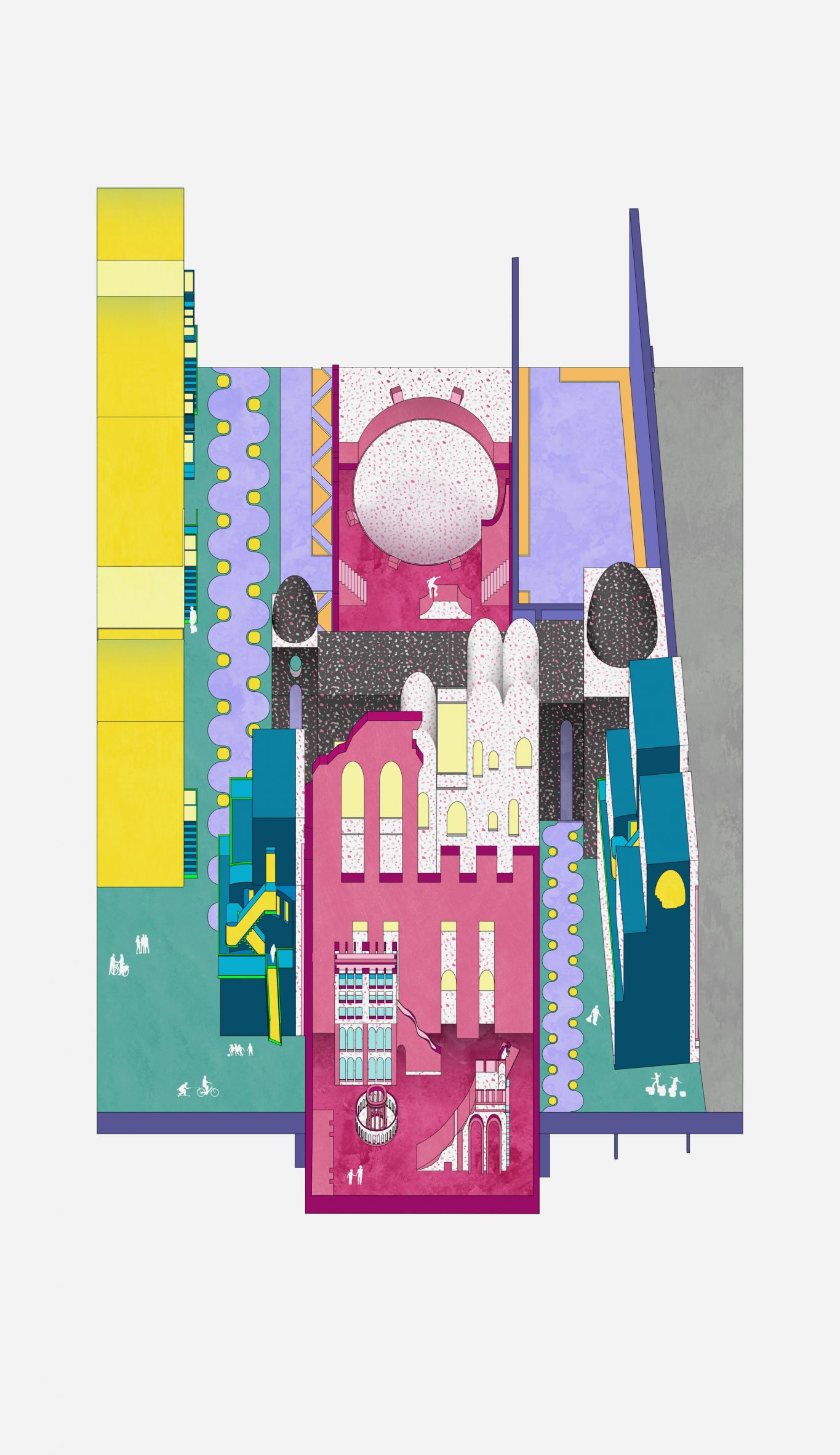
The Social Bank by Maria Gross, Byron Roberts, Erfan Khosravi and Marlene Ortner
"The project aims to redefine the purpose of a former bank, transforming it from a depository of monetary assets into a symbol of social prosperity.
"For this purpose, the bank will be transformed into social housing, including workshops and garden areas to make it a hub of sociability and create a place of socio-cultural interaction.
"By reusing parts of the original ruins and recasting units out of the crushed ruins, a visual and functional distinction is created between the old and the new.
"The original ruins will not be altered, while the units will be recast into shapes reminiscent of the earlier ruins – the remains of the past can still be seen in the new complex and illustrate the possibility of coexistence between past and present facilities.
"The new Bank of England is now protecting a social value, a symbol of conviviality that preserves the social wealth of a multicultural and multigenerational London."
Students: Maria Gross, Byron Roberts, Erfan Khosravi and Marlene Ortner
Studio: Studio Sam Jacob
Tutors: Sam Jacob, Sophie Grell-Prix, Eldine Heep, Sophie Luger and Giacomo Pala
Emails: maria.gross[at]student.uni-ak.ac.at, erfan.khosravi[at]student.uni-ak.ac.at, marlene.ortner[at]student.uni-ak.ac.at and byron.roberts[at]student.uni-ak.ac.at
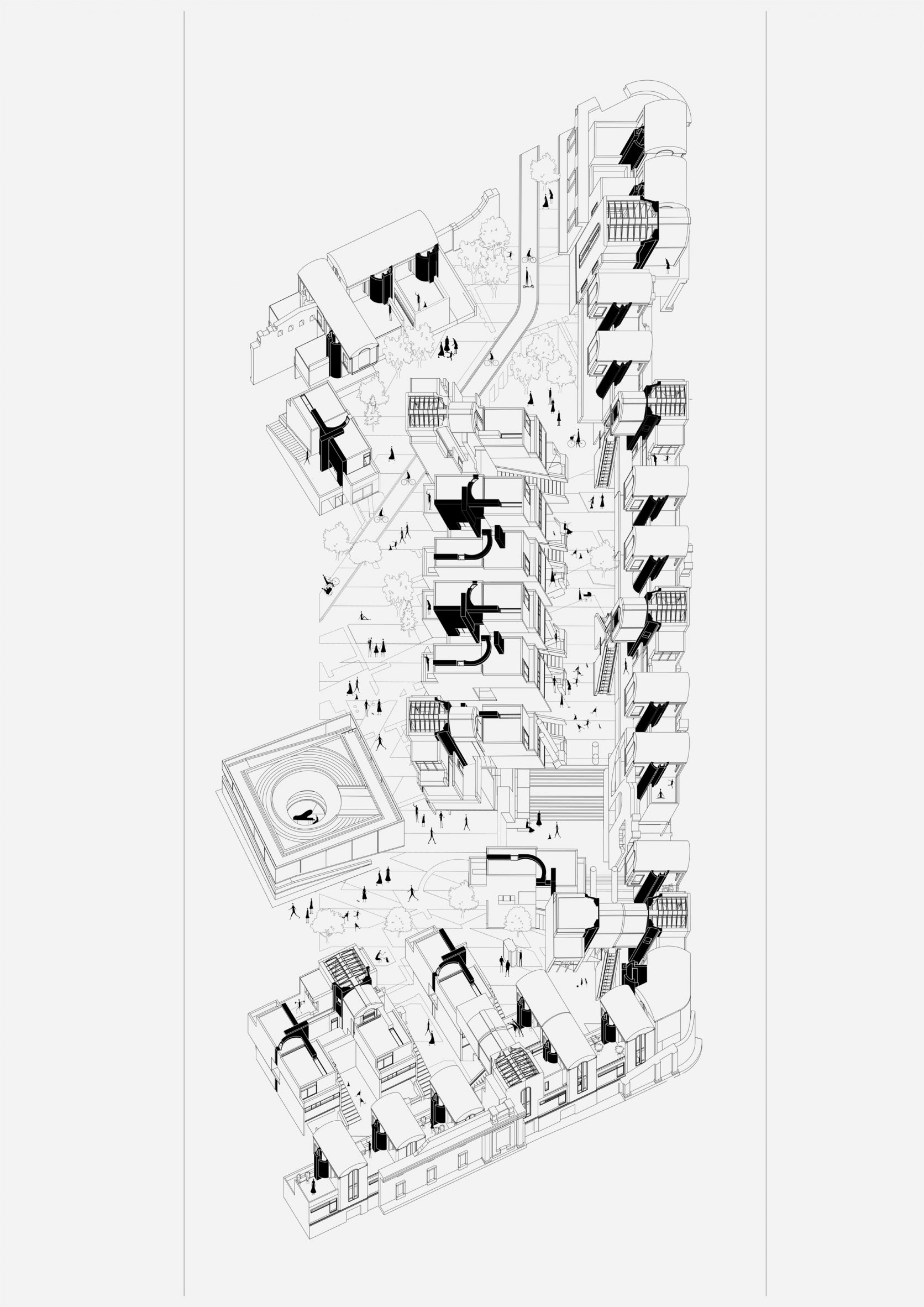
Street Circus by Jonas Ramoser, Eda Sefa, Zhongzheng Zhang and John Clayson
"The Street Circus project proposes social housing that opens up a historically opaque site.
"The project looks to soften the site's boundary by fragmenting its walls, creating a grey spectrum of blurred publicity and visual permeability.
"The project moves away from the notion of constructed monumental ruins and becomes a tool to represent the past and to inform the internal spatial experience."
Students: Jonas Ramoser, Eda Sefa, Zhongzheng Zhang and John Clayson
Tutors: Sam Jacob, Sophie Grell-Prix, Eldine Heep, Sophie Luger and Giacomo Pala
Studio: Studio Sam Jacob
Emails: jonas.ramoser[at]student.uni-ak.ac.at, eda.sefa[at]student.uni-ak.ac.at, zhongzheng.zhang[at]student.uni-ak.ac.at and john.clayson[at]student.uni-ak.ac.at
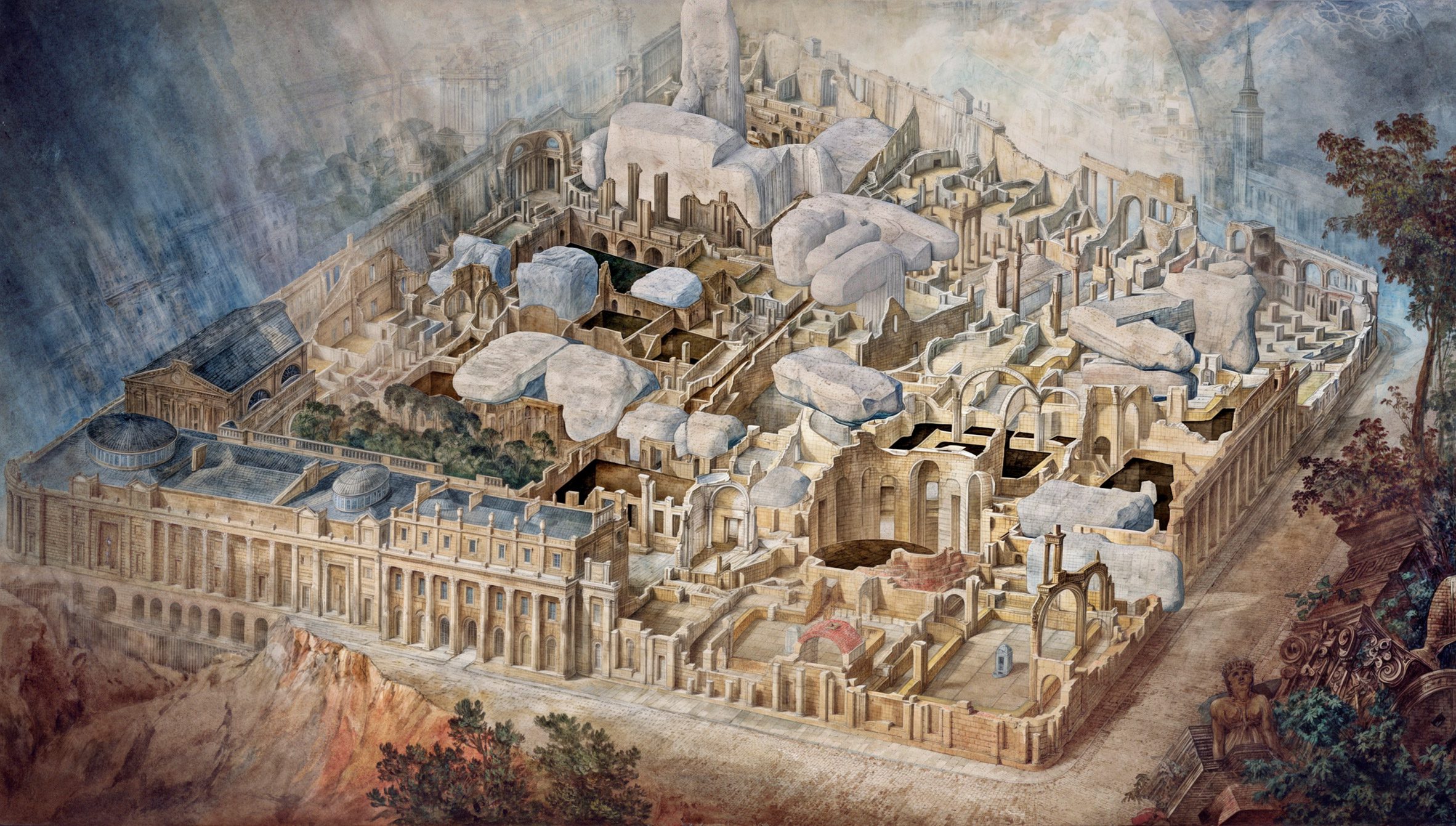
Sticks and Stones: Ruination by Addition by Allen Bell, Hoda Balouchi and Yurii Brytov
"Sticks and Stones is an exploration into how the material processes that lead to the construction and ultimate dilapidation of a built architecture can take more precedence in the representation of an architectural idea.
"By examining the Gandy representation of the Soanian ruins of the Bank of England as an expression of form and texture, ruination through rustication as an aesthetic virtue and the monolith become important tactics for Sticks and Stones, synthesising to introduce a strong formal weight to the otherwise light and textural representation of the site's condition.
"Through an introduction of a site treatment of large stone chunks, the opportunity to play upon the idea that a ruin and a ruin form are the results of two contradictory processes of erosion and construction forms emerges."
Students: Allen Bell, Hoda Balouchi and Yurii Brytov
Studio: Studio Sam Jacob
Tutors: Sam Jacob, Sophie Grell-Prix, Eldine Heep, Sophie Luger and Giacomo Pala
Emails: allen-david.bell[at]student.uni-ak.ac.at, hoda.balouchi[at]student.uni-ak.ac.at and yurii.brytov[at]student.uni-ak.ac.at
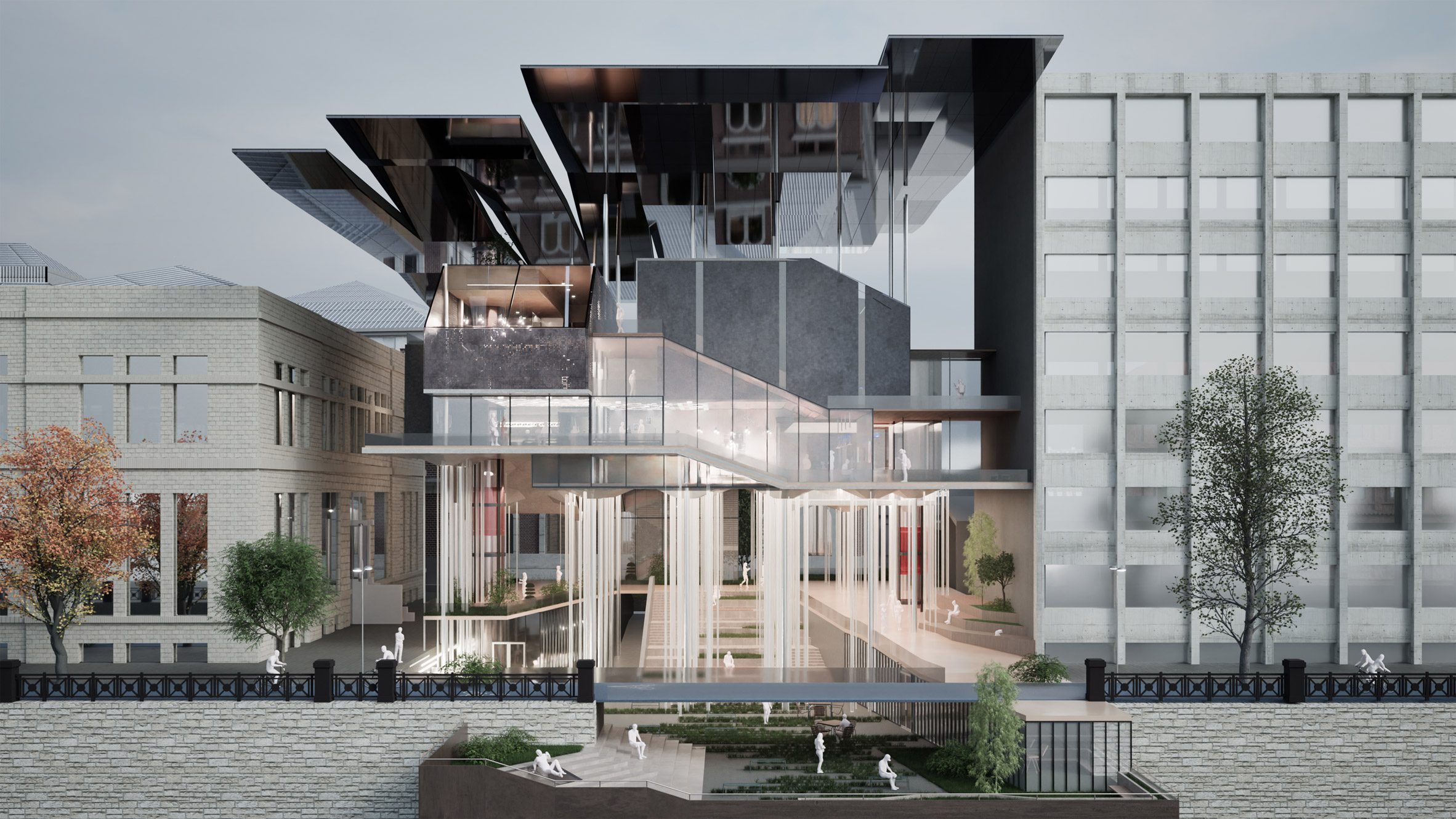
Interwoven Horizons by Emma Schwarz, Özge Taspinar and Shandeep Suresh
"The Angewandte extension project aims to foster spontaneous interactions among people from diverse backgrounds by reimagining urban space through three distinctive layers: ground, elevated spaces and roof.
"The ground layer draws inspiration from the hypostyle hall concept, providing an inviting venue for gatherings and public events – supported by columns aligned with upper volumes, it creates varied ceiling heights, enhancing spatial dynamics.
"The interlocking volumes above prioritise connectivity, forming overlapping zones that promote interaction between different user groups through shared spaces and visual connections.
"Meanwhile, the dynamic roof design mirrors the Wienfluss's fluidity, acting as a prominent city landmark that integrates the building with its surroundings.
"Overall, the Angewandte extension exemplifies a harmonious blend of architectural innovation and community engagement, designed to enrich urban life through its interconnected spaces and vibrant social environment."
Students: Emma Schwarz, Özge Taspinar and Shandeep Suresh
Studio: Studio Greg Lynn
Tutors: Greg Lynn, Lenia Mascha, Maja Ozvaldic, Bence Pap and Kaiho Yu
Emails: emmaschwarz38[at]gmail.com, ozgetpinar[at]gmail.com and shandeepsuresh[at]gmail.com
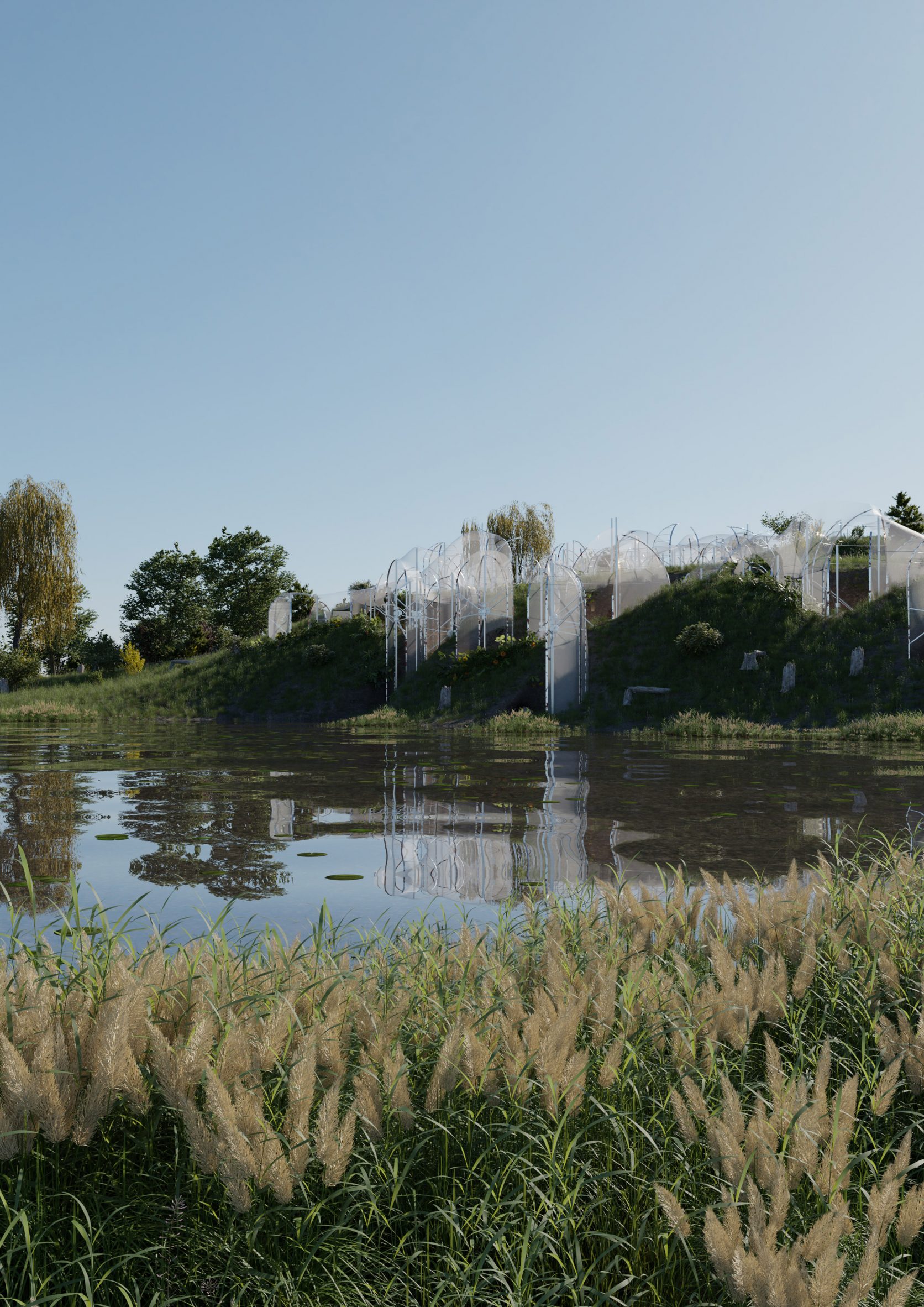
Unlocking Ground by Ivy Aris, Tizian Glanzer, Lotte Riemer and Marian Stein
"In an attempt to create an expanded habitat for the beavers of Prater, the project proposes a system of vertical extraction of soil from Konstantinhuegel, which is relocated through an overhead grid to build riverbanks around the site, forming a closed-loop system of material flow.
"The project offers a method of creating space for both beavers and humans, calling for a recalibration of our anthropocentric views on space-making – instead of prioritising architectural moves for people, the project first unlocks soil from the mound, repurposing it as riverbanks for beavers to construct their habitats.
"The subsequent voids left from this extraction become the secondary spatial model of the proposal, as these spaces are made inhabitable by structures inserted after extraction with the artefacts left behind – the secondary structure is made of synthetic elastic, a seemingly irrational material chosen to retain the heavy mass, inspired by the absurdity of the amusement park in Prater.
"This material is intended to decay through exposure to the elements and generated movements – both the soil and the elastic bracing will eventually reach a point of exhaustion, causing the structure to partially cave in on itself, offering yet another generation of exposed earth.
"This approach encourages a harmonious coexistence, embracing ecological changes and promoting a more inclusive and sustainable urban environment."
Students: Ivy Aris, Tizian Glanzer, Lotte Riemer and Marian Stein
Studio: Studio Diazmoreno Garciagrinda
Tutors: Cristina Díaz Moreno and Efren García Grinda, Christina Ehrmann, Christopher Gruber, Anna Gulinska, Zsuzsa Péter and Hannes Traupmann
Emails: ivy.aris[at]student.uni-ak.ac.at, tizian.glanzer[at]student.uni-ak.ac.at, lotte.riemer[at]student.uni-ak.ac.at and marian.stein[at]student.uni-ak.ac.at
Partnership content
This school show is a partnership between Dezeen and the University of Applied Arts Vienna. Find out more about Dezeen partnership content here.